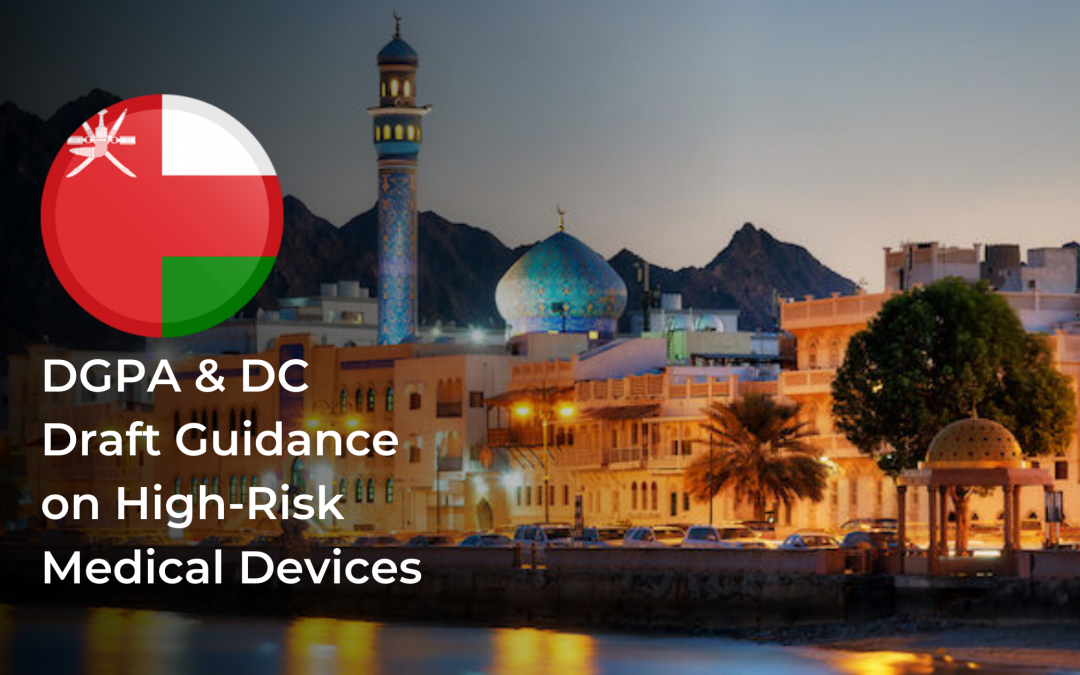The Directorate General of Pharmaceutical Affairs & Drug Control (DGPA & DC), the regulating authority in the sphere of healthcare products of the Sultanate of Oman, has published draft guidance dedicated to regulatory requirements for the registration of high-risk medical devices.

Regulatory Background
The present draft guidance provides additional clarifications concerning DGPA & DC regulatory requirements to be applied when registering high-risk medical devices intended to be marketed and used in the sultanate of Oman. The authority encourages medical device manufacturers and importers to follow the recommendations provided in the guidance to facilitate the regulatory procedures to be performed. In particular, the authority mentions that in case of submitting an application with a wrong class of a medical device indicated, a new submission with a correct class would be required, which will result in additional delays. The authority mentions that according to the applicable legislation, marketing approvals granted in other jurisdictions could be recognized in the sultanate of Oman.
First of all, the authority provides the definitions of the most important terms and concepts used in the context of the guidance including, inter alia, the following ones:
- High-Risk Medical Device – the one associated with High Individual Risk and High Public Health Risk;
- Registration – the process by which a party submits information to the Regulatory Authority in a jurisdiction, regarding the identification and establishment location(s) of the manufacturer and other parties, responsible for supplying a medical device(s) to the market in that jurisdiction;
- Listing – the process whereby a party submits information to the Regulatory Authority in a jurisdiction, regarding the identification of a medical device(s) that is or will be supplied to the market in that jurisdiction;
- Label – the written, printed, or graphic information appearing either on the device itself, or on the packaging of each unit, or the packaging of multiple devices;
- Risk – a combination of the probability of occurrence of harm and the severity of that harm;
- Intended use/purpose – the objective intent of the manufacturer regarding the use of a product, process, or service as reflected in the specifications, instructions, and information provided by the manufacturer.
Apart from the ones listed hereinabove, the guidance also provides the definitions of such terms as: “Medical Device”, “Manufacturer”, “Accessories” and “Accessory to a medical device”.
General Requirements
According to the applicable DGPA & DC regulatory requirements, to be allowed for marketing and use, all medical devices should be listed in the medical device control department database. Current legislation also provides change control requirements prescribing that the manufacturer shall duly document the changes made to the medical device and provide the appropriate documentation to the regulating authority upon request. The application for inclusion in the aforementioned medical device control department database should be submitted via the online portal. The fees payable would depend on the class of the device subject to registration under the applicable risk-based classification. The authority additionally emphasizes that the application should meet the requirements regarding the dossier format, while the authority is entitled to request additional information or introduce new requirements, should it be reasonably necessary due to the specific features of the medical device in question.

Requirements for Dossier
The DGPA & DC guidance further describes the structure of the dossier file related to a high-risk medical device. According to the guidance, a dossier should contain the following sections:
- Section 1: Application form. In this section, the details about the applicant entity should be provided.
- Section 2: Manufacturer information. According to the guidance, it is necessary to provide contact details of the manufacturer of a medical device in question, as well as the information regarding the quality management system employed by the manufacturer, certificates it holds, and also such documents as the audit report and risk management file (RMF). The latter should cover such aspects as: Procedure; Risk management plan; Risk analysis; Risk management report; and Benefit-risk analysis.
- Section 3: Medical Device information. In this section, the details about the medical device subject to review should be provided. This includes the information about the medical device itself (e.g., trade name, an indication of a class and category, intended use, description of a principal mode of action), as well as the details on medical device grouping/bundling and an indication of the appropriate jurisdiction.
- Section 4: Device Labelling. In this section, the applicant should provide comprehensive information about the labeling to be used, the packaging, the instructions for use accompanying the device, and also all marketing materials to be used.
- Section 5: Essential Principles & evidence of conformity. In this section, the applicant shall provide the evidence demonstrating compliance of the medical device in question with any all applicable regulatory requirements it is subject to. In particular, the regulating authority refers to the Essential Principles of safety and performance. The authority additionally emphasizes the following:
- Conformity to each of the applicable Essential Principles should be duly validated;
- Should the applicant decide not to apply any of the Essential Principles, the appropriate justification of such an approach should be provided;
- It is necessary to indicate the connection between each of the Essential Principles and respective documents.
- Section 6: Summary of design Verification & Validation documents. The scope of this section covers the aspects related to the design of the medical device in question, and also the manufacturing process. According to the guidance, the information to be provided in this section should include:
- Full device description (including drawings and description of subsystems);
- Design Stages (a detailed enough description of all the design stages, verification, and validation procedures);
- Manufacturing process;
- Manufacturing structure.
- Section 7: Product Verification and Validation. In this section, the applicant shall provide information about the relevant certificates related to the device (e.g., CE certificate or TSE free certificate for biological products).
- Section 8: Clinical evidence. In this section, the manufacturer should provide a clinical evaluation report.
- Section 9: Post Market control. According to the applicable regulatory requirements, medical device manufacturers are obliged to submit periodic safety update reports (PSUR) concerning each medical device they are responsible for. Such a report should contain a summary of the post-market surveillance data collected in the course of the appropriate activities. It is further stated that PSUR should indicate:
- The conclusions of the benefit-risk determination;
- The main findings of the Post-market clinical follow-up (PMCF);
- The volume of sales of the device and an estimate of the size and other characteristics of the population using the device and, where practicable, the usage frequency of the device;
- Manufacturers of high-risk devices (C&D) shall update the PSUR at least annually.
- Section 10: Status of device distribution. This section should contain the list of countries where the medical device in question is marketed, confirmed by the appropriate free sale certificates.
- Section 11: Declaration of conformity. In this section, the manufacturer of the medical device should declare that the product meets all applicable regulatory requirements.
In summary, the present guidance provides an overview of the applicable regulatory requirements and provides additional recommendations to be taken into consideration by medical device manufacturers and other parties interested in placing medical devices on the market of the sultanate of Oman. The document also highlights the main points to be covered by the applicant to be submitted when applying for marketing approval.
Sources:
Why Choose Us?
RegDesk is a next-generation web-based software for medical device and IVD companies. Our cutting-edge platform uses machine learning to provide regulatory intelligence, application preparation, submission, and approvals management globally. Our clients also have access to our network of over 4000 compliance experts worldwide to obtain verification on critical questions. Applications that normally take 6 months to prepare can now be prepared within 6 days using RegDesk Dash(TM). Global expansion has never been this simple.


